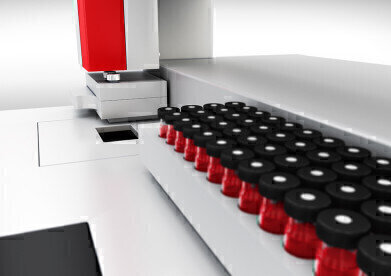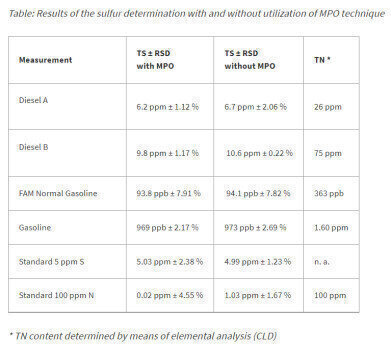-

-

-
 Image 3 : Table: Results of the sulphur determination with and without utilisation of MPO technique
Image 3 : Table: Results of the sulphur determination with and without utilisation of MPO technique
Analytical Instrumentation
Elimination of Nitrogen Interferences for the Detection of Sulphur in Fuels
Sep 14 2021
Total sulphur (TS) is a routine parameter in the quality control of fuels. However, analysis can prove challenging as nitrogen interferences can distort results. Now, innovative technologies are available that suppress these interferences and save laboratories a lot of time and effort in the analysis process.
UV fluorescence is usually used to measure TS. The cross-sensitivity involved with nitrogen, however, means that there are interferences in this method that can affect results. This article explains how you can easily avoid these and thus speed up your analyses.
Cross-sensitivity of nitrogen and UV fluorescence
In the production of motor fuels through the hydrogenation of coal or plant oils and the production of conventional mineral oil-based fuels with biodiesel additives, the ignition properties of the end products may be impaired. In these cases, special additives – generally referred to as cetane improvers – are used to improve the fuel’s ignition properties (cetane number). Nitrogen compounds such as amyl nitrite, cyclohexyl nitrite, triethylene glycol dinitrate or 2-ethylhexyl nitrate (2-EHN) have proven to be especially suitable and cost-effective. These substances not only have a positive effect on ignition properties but also increase the nitrogen content of the end product. When measuring TS content, this is a problem, as the nitrogen can produce false-positive results. Many fuels classified as sulfur-free already exhibit an actual TS content close to the statutory limit of 10 ppm (ASTM D4814, D6751//DIN EN 590, DIN EN 14214). If a nitrogen-based cetane improver is used, the sulphur content measurement may misleadingly exceed the specified limit, in which case the fuel will no longer satisfy requirements and a complex treatment process becomes necessary.
“Micro Plasma Optimisation” provides a solution to the problem of interferences
However, this additional effort can be avoided if a matrix-independent UV detection method is used that enables differentiation between sulphur and nitrogen interference. One effective technology that achieves this is micro plasma optimisation (MPO), an evolution of the conventional UV fluorescence from Analytik Jena. It guarantees reliable results within a very short time, even despite interferences. MPO converts the interfering NO molecules into harmless species. This eliminates the need for extra additives such as catalysts, multiple injectors or matrix separation using trap & release methods. Analytik Jena uses MPO technology in solutions such as the combustion elemental analysers of the compEAct and multi EA 5100 series, which are frequently used in the oil and gas industry for sulphur measurement in fuels.
Reliably measuring of total sulphur in fuels using the compEAct S
An example measurement shows here how truly effective MPO technology is. Here, various fuel samples with nitrogen additives as well as sulfur and nitrogen-based standard solutions are analysed using the compEAct SMPO. Thanks to the integrated HiPerSens detector, the sample does not need to undergo complex preparation. Specially developed for fuel applications, this elemental analyser enables reliable analysis of sophisticated matrices and simplifies routine tasks by reducing the risk of operating errors and substantially shortening the processing time of each sample regardless of concentration.
Measurement of fuel samples
To calibrate the measurement system for the relevant concentration range, liquid standards based on dibenzothiophene (S) in iso-octane are used. Specific calibration strategies are not required, as the compEAct performs combustion in a manner that is optimised for the matrix. For all samples, a volume of 10 μL was injected directly into the combustion tube. Quantitative combustion occurred at 1050°C. For this process to be performed quickly and in a matrix-independent manner, a specially designed quartz glass reactor, including a quartz pyrolyzer, was used. The intelligent management of the process gases enables lighter sample components to evaporate quickly and safely in a pure, inert carrier gas atmosphere. Heavier components are pyrolyzed quickly in a controlled fashion on the active surface of the quartz pyrolyzer. This ensures that only the gaseous components reach the combustion zone in the first stage of the process. In the second stage, the pyrolysis products and other heavier sample components that are retained by the quartz pyrolyzer undergo a quantitative reaction in the presence of pure oxygen. Before the combustion gases reach the MPO, they are purified and dried. All interfering nitrogen compounds are then removed by the powerful cold plasma ionization. The remaining SO2 is then detected using UV fluorescence.
Results
The analysis results obtained by these means and their reproducibility are evidence of the quality of the exploratory process. The overall performance of the compEAct SMPO has been validated by means of an analysis of a TS standard with a known concentration. The analyser enabled rapid and interference-free measurement of sulphur content in fuels in the presence of nitrogen-based additives. Please see image 3*
The complete and detailed documentation of the measurement can be found in our related application note.
Digital Edition
PIN 25.1 Feb/March
March 2024
In This Edition Safety - The technology behind the ION Science Tiger XT - Safety with ammonia and LOHCs as hydrogen carriers Analytical Instrumentation - Discussion on new tribology te...
View all digital editions
Events
Apr 28 2024 Montreal, Quebec, Canada
Apr 30 2024 Birmingham, UK
May 03 2024 Seoul, South Korea
May 05 2024 Seville, Spain
May 06 2024 Riyadh, Saudi Arabia

















